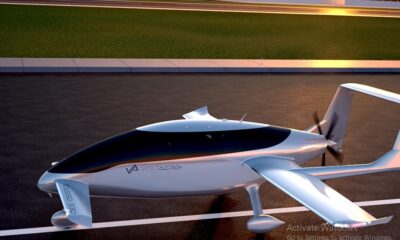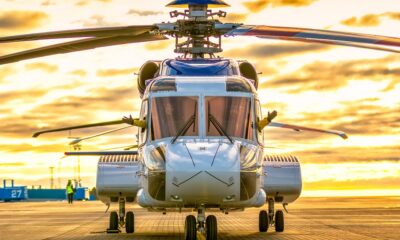Aerospace
First Glimpse of Hungary’s KC-390 Aircraft by Embraer

A Brazilian company called Embraer is making a special airplane for the Hungarian Air Force. This plane is called the KC-390, and it’s going to be ready in 2024.
The KC-390 for Hungary has everything the Hungarian Air Force asked for, including a special pipe for refueling in the air. This pipe helps the plane stay in the sky longer.
They just turned on the electricity in the first KC-390 for Hungary. This means the plane’s electrical system is working. Next, they’ll add more systems and test how it flies.
What’s cool about the KC-390 for Hungary is that it has a special medical room, like a hospital, inside. This is important for helping people during emergencies, like natural disasters.
The KC-390 can do a lot of different jobs, like carrying cargo and troops, dropping supplies from the sky with precision, and even sending paratroopers into action. It can also refuel other planes while flying.
This plane is part of Hungary’s agreement with Embraer. They are getting two of these KC-390 planes to make their Air Force stronger. The first one will arrive in 2024.
Embraer is also working closely with Hungary. They have opened an office in the capital, Budapest, to work together on future projects. This partnership will help both sides, with a focus on long-term projects and advanced technology.
So, Hungary is getting a powerful new plane, the KC-390, to help its Air Force, and Embraer is working closely with Hungary to build a strong partnership.
These KC-390 are fully NATO compatible, not only in terms of its hardware but also in its avionics and communications configuration. Furthermore, the KC-390 probe and drogue refueling system means the aircraft can refuel the Hungarian JAS 39 Gripen, as well as other aircraft that use the same technology.
In August 2021, Embraer announced the opening of an office in Budapest, the capital of Hungary, with the main objective to foster cooperation in the country. This initiative is part of Embraer’s strategy to establish new partnerships in select markets. Some of the key aspects of this future cooperation are the collaborative efforts with new partners, long-term projects, and investment in reliable dual-use technology.
Aerospace
Weather forecasting, from space to your smartphone

In the modern age, checking the weather forecast has become as effortless as tapping a few buttons on your smartphone. Yet, the journey from ancient weather sayings to today’s advanced predictions is a testament to human ingenuity and technological innovation.
At the heart of this transformation lies the crucial role of satellites, particularly exemplified by the cutting-edge MetOp-SG satellites crafted by Airbus for the European Space Agency (ESA) and EUMETSAT.
Satellites like MetOp-SG serve as the vanguards of weather forecasting, providing an extensive array of precise data essential for enhancing numerical models and climate monitoring. Without these orbiting observers, the accuracy and reliability of weather forecasts would be greatly compromised.
Philippe Chambon, a researcher at Météo-France, underscores the pivotal role of satellite data, emphasizing that approximately 90% of the information utilized in numerical weather prediction models originates from Earth observation satellites like MetOp-SG. With its advanced instrumentation, these satellites promise to revolutionize forecasting accuracy, enabling meteorologists to anticipate weather patterns with unprecedented precision both globally and regionally.
But how does this process unfold? Imagine the atmosphere as a complex puzzle, with each piece representing various atmospheric parameters like temperature, humidity, wind patterns, and precipitation. Through a sophisticated network of observations, simulations, and analysis powered by numerical models, meteorologists decipher this puzzle to generate comprehensible weather forecasts for the masses.
The familiar icons of sun, clouds, and temperature readings that populate weather apps on our smartphones are the tangible outcomes of this intricate process—a culmination of data collection, analysis, and interpretation condensed into easily digestible information.
Beyond mere convenience, weather forecasting plays a critical role in safeguarding lives and livelihoods. By anticipating and warning against impending natural disasters such as storms and heatwaves, forecasters provide vital lead time for communities to prepare and mitigate potential damage, ultimately saving lives and preserving economic stability.
In essence, weather forecasting is a remarkable fusion of cutting-edge technology, scientific expertise, and human foresight. From the vast expanse of space to the palm of your hand, the journey of weather data underscores the remarkable progress humanity has made in understanding and predicting the complexities of the atmosphere, ensuring a safer and more informed tomorrow for all.
Aerospace
VoltAero Performs the World’s First Flight of an Electric-Hybrid Aircraft

In a first for the aviation industry, TotalEnergies’ 100% sustainable fuel was used to power the patented electric-hybrid powertrain for VoltAero’s Cassio line of aircraft.
The historic flight was conducted from VoltAero’s Royan, France, research and development centre. It used both the hybrid powertrain’s electric mode and its internal combustion engine, which was fueled by TotalEnergies’ Excellium Racing 100, a bioethanol made from waste that comes from French vineyards.
By validating its electric-hybrid powertrain and the use of sustainable fuels, VoltAero’s Cassio S testbed aircraft was used for this significant demonstration, reducing the risk of airworthiness certification for upcoming production versions of the Cassio aircraft family.
The VoltAero propulsion concept is unique: Cassio aircraft will utilize an electric motor in the aft fuselage-mounted hybrid propulsion unit for all-electric power during taxi, takeoff, primary flight (if the distance traveled is less than 150 km.), and landing. The hybrid feature – with an internal combustion engine – comes into play as a range extender, recharging the batteries while in flight. Additionally, this hybrid element serves as a backup in the event of a problem with the electric propulsion, ensuring true fail-safe functionality.
Airplane Scale Model collectionThe Cassio 330, with a four- or five-seat interior and 330 kilowatts of combined electric-hybrid motor, will be VoltAero’s first production aircraft. The six-seat Cassio 480 and the 10- or 12-seat Cassio 600, both of which have electric-hybrid propulsion systems with 480 and 600 kilowatts of combined power, will come after it.
Aerospace
GKN and Pratt & Whitney collaborate to develop EWIS for hybrid demonstrator

Pratt & Whitney Canada and GKN Aerospace have a contract in place to work together on the creation of the High Voltage High Power EWIS for the RTX hybrid-electric flight demonstration project. The demonstrator, which aims to have a 30% increase in fuel efficiency and a reduction in CO2 emissions compared to the most modern regional turboprop aircraft currently in use, will also have its electrical wiring system developed, built, and installed as part of the arrangement.
The hybrid-electric propulsion system of the demonstrator combines a fuel-burning engine from Pratt & Whitney with a 1-megawatt electric motor created by Collins Aerospace. More effective engine performance will be possible during the various flying phases, including takeoff, climb, and cruise, through the hybrid-electric system. Business divisions of RTX include Collins Aerospace and Pratt & Whitney.
The development and design of the High Voltage High Power EWIS for the hybrid-electric propulsion system will be led by GKN Aerospace in the Netherlands. After the design process, GKN Aerospace will be in charge of producing the required hardware and mounting it on the demonstrator aircraft.
Modern electrical distribution systems that are powering a substantial portion of today’s passenger flights and military aircraft are provided by GKN Aerospace, a renowned leader in engine systems and EWIS solutions for aircraft. Teams from all over the world, including Montreal, Canada, where the hybrid-electric flight demonstrator project is situated, provide assistance for GKN Aerospace’s EWIS centre of competence in the Netherlands.
-

 Aerospace7 months ago
Aerospace7 months agoVoltAero Performs the World’s First Flight of an Electric-Hybrid Aircraft
-

 Aerospace7 months ago
Aerospace7 months agoThe Art and Science of Crafting Airbus A350 Wings
-

 Aerospace7 months ago
Aerospace7 months agoS-92 Helicopter: A Journey from Ocean Rescues to Sustainable Aviation Fuel Innovation
-

 Aerospace7 months ago
Aerospace7 months agoAirbus partners with DG Fuels to foster sustainable aviation fuel production in the United States
-

 Aerospace7 months ago
Aerospace7 months agoGKN and Pratt & Whitney collaborate to develop EWIS for hybrid demonstrator
-
Uncategorized5 months ago
Difference between NASA and Space-x
-

 Research5 months ago
Research5 months agoBoeing’s Eco Demonstrator and NASA Investigate Sustainable Aviation Fuel Benefits
-

 Research2 months ago
Research2 months agoThe world’s first metal 3D printer for space is on its way to the ISS


